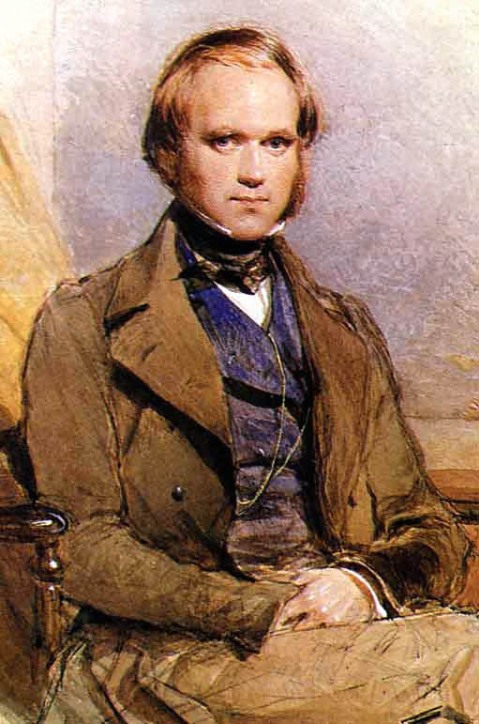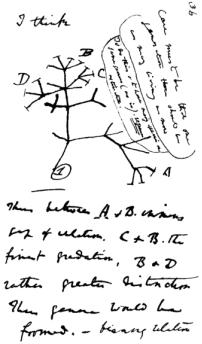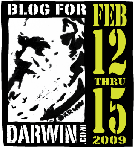Happy birthday, Charles Robert Darwin

Charles Darwin, about age 30, shortly after his return from the voyage of the Beagle. If he were still alive, he'd be 200 years old today.
Today is the 200th birthday of Charles Darwin (and of Abraham Lincoln too; they were born within hours of each other). Darwin, who I have previously blogged about here, ranks with Newton and Einstein as one of the most important scientists of all time. So take a bit of time today to learn more about this extraordinary individual.
To humanize him and add some context and framework for his accomplishments, here is a brief time line of some notable events in Darwin’s life, which may contain some facts that you don’t yet know about the great naturalist:
12 February 1809: Charles Robert Darwin was born in Shrewsbury, Shropshire, England, the fifth of six children to physician Robert Darwin and Susannah (née Wedgwood) Darwin, the daughter of industrialist Josiah Wedgwood (1730- 1795).
1825–1828: Studies medicine at the University of Edinburgh. He joins the Plinian Society, a group for students interested in natural history. He gives up medicine because he can’t stand the sight of blood and 19th century surgery.
1828–1831: At his father’s urging, he begins preparing for a career in the clergy; he studies theology at Christ’s College, University of Cambridge, in preparation for a career as a parish priest. He collects beetles and enrolls in a course run by Rev. John Stevens Henslow, professor of botany.
1831–1836: At the suggestion of Rev. Henslow, he accompanies Captain Robert FitzRoy (1805–1865), future admiral and Governor of New Zealand, on the second survey expedition of HMS Beagle as an unpaid naturalist. Originally planned to take two years, the five-year voyage takes him across the Atlantic to the southern part of South America, returning via Tahiti and Australia; the Falkland Islands, Argentina, Chile, Peru, Australia, New Zealand, Mauritius and South Africa featuring on his extensive itinerary. He observed the behavior of different plant and animal species, and analyzed his large collection of specimens for three months on his return.
1838: Moves to London and, once compiled, he begins publishing his findings in various papers and volumes.
1839: Journal and Remarks (later known as The Voyage of the Beagle) appears in print and he is elected a Fellow of the Royal Society on 24 January. Five days later he marries his cousin Emma Wedgwood (1808–1896), the youngest of seven children to potter Josiah Wedgwood II (1769–1843), and his wife Bessy. They would have 10 children, two sadly dying in infancy. George, Francis and Horace became, respectively, an astronomer, botanist and civil engineer of repute. Charles and Emma were avid backgammon players; he faithfully records the results of their nightly games for many years.
1842: The Darwins move to Downe House in the village of Downe, Kent. He does his theorizing in his home study, in part so he can be close to his children. He publishes his first book on a specific subject, The Structure and Distribution of Coral Reefs.
1853: He is awarded the Royal Society’s Gold Medal for his four volumes on barnacles.
1856: Darwin becomes aware of Alfred Russell Wallace’s theories on evolution and is persuaded to finally publish his work to establish priority.
1858: The outlines of his natural selection theories are jointly published alongside the similar theory proposed by Alfred Russell Wallace (1823-1913) in the Journal of the Proceedings of the Linnean Society. His grandfather, scientist Erasmus Darwin (1731-1802), was one of those who had already argued in favour of evolutionary ideas.
1859: His epic On the Origin of Species, a collection of evidence collected from the study of fossils, comparisons of anatomy and embryology, appears after more than 20 years in the making. It presents a theory in which living beings are related by common genealogical descent; discourses that life on earth adapts according to its environment; and offers views on such concepts as natural selection, adaptation and survival of the fittest.
1871: The Descent of Man, and Selection in Relation to Sex is published; it links, in Part I, some of the ideas detailed in On the Origin of Species to the concept of human evolution, a topic already being discussed in detail by peers, and looks at the relationship between human sexes and races, responding to the thoughts and works of other writers in the process. In Part II and Part III, the book focuses on what he calls “sexual selection.”
1872: The Expression of the Emotions in Man and Animals is published; it looks at how humans and animals communicate their emotions.
1877: He is awarded an honorary degree from the University of Cambridge.
19 April 1882: He dies in Downe and is subsequently buried near Isaac Newton in Westminster Abbey following one of only five state funerals given to a non-royal in the 19th century.
Darwin continued his research throughout his life and his work was not merely confined to the biological sciences.

One of the first evolutionary trees ever drawn, with the words "I think" written above it, from one of Darwin's notebooks.*
His first specific-subject book, The Structure and Distribution of Coral Reefs, published in 1842, set out his theory—controversial for decades but later proven correct—of how atolls form, overturning the prevailing theories of his day. His last work, published the year before he died, The Formation of Vegetable Mould, Through the Actions of Worms, With Observations on Their Habits, analyzed the role that worms play in soil creation. His conclusions, once again, would be proven correct with time.
Darwin was a skilled writer and very effective at conveying his thoughts and ideas—and not just scientific ideas; his other works include interesting travelogues and an autobiography. Almost all of his writings, including some of the most speculative, have aged very well.
I cannot help including an example, and if it is a long one it is, I hope, a good one. Consider the concluding paragraph to his best-known work, On the Origin of Species, which sums up with some degree of poetry the whole work:
It is interesting to contemplate an entangled bank, clothed with many plants of many kinds, with birds singing on the bushes, with various insects flitting about, and with worms crawling through the damp earth, and to reflect that these elaborately constructed forms, so different from each other, and dependent on each other in so complex a manner, have all been produced by laws acting around us. These laws, taken in the largest sense, being Growth with Reproduction; Inheritance which is almost implied by reproduction; Variability from the indirect and direct action of the external conditions of life, and from use and disuse; a Ratio of Increase so high as to lead to a Struggle for Life, and as a consequence to Natural Selection, entailing Divergence of Character and the Extinction of less-improved forms. Thus, from the war of nature, from famine and death, the most exalted object which we are capable of conceiving, namely, the production of the higher animals, directly follows. There is grandeur in this view of life, with its several powers, having been originally breathed into a few forms or into one; and that, whilst this planet has gone cycling on according to the fixed law of gravity, from so simple a beginning endless forms most beautiful and most wonderful have been, and are being, evolved.
If you want to learn more about Charles Darwin’s early life and family life, along with the discoveries that led to his formation of the theory of evolution, I highly recommend the following hour-long video of a 2005 lecture by Sean Carroll, titled (not coincidentally) “Endless forms most beautiful.”
Carroll is a great lecturer and the video includes many slides and videos that I think will hold your attention if you have even the smallest bit of interest in the subject.
 For more on the Charles Darwin, see the excellent series of articles that Wikipedia has covering his whole life. For more on the theory of evolution, which is one of the most important and central in all of science, see their introduction to evolution and the somewhat more technical article on the theory itself. Berkeley has a nice page with explanations of evolution, the importance of the theory, and the many forms of evidence on which it is based.
For more on the Charles Darwin, see the excellent series of articles that Wikipedia has covering his whole life. For more on the theory of evolution, which is one of the most important and central in all of science, see their introduction to evolution and the somewhat more technical article on the theory itself. Berkeley has a nice page with explanations of evolution, the importance of the theory, and the many forms of evidence on which it is based.
__________
* This post originally identified Darwin’s sketch as “the first evolutionary tree ever drawn.” However, as commenter Zen Faulkes points out (see comments below), Jean Baptiste Lamarck had previously drawn a similar sketch. This blog regrets the error.

[…] is the 200th birthday of Abraham Lincoln (and of Charles Darwin too; they were born within hours of each other). Given the bicentennial, it might be fitting and […]
happy b-day to charles darwin
A minor correction to an otherwise fine article. Darwin’s notebook sketch is described as, “The first evolutionary tree ever drawn…”
Actually, the honor of the first tree goes to Jean Baptiste Lamarck, as noted in a recent letter by Mark Wheelis to Science. Lamarck’s tree is probably nearly forgotten because it shows a specific hypothesis that is dramatically wrong. Darwin’s tree is more general and conceptual.
Wheelis M. 2009. Darwin: Not the First to Sketch a Tree Science 315(5812): 597. doi: 10.1126/science.315.5812.597a
Zen Faulkes: I stand corrected. Thank you.
I’ve corrected the post and indicated the change. Thanks for the citation!